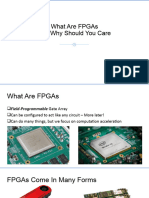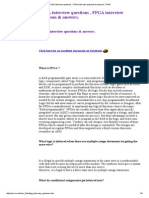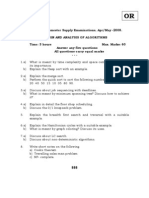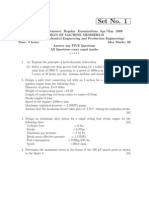0 ratings0% found this document useful (0 votes)
26 viewsFpga
An FPGA (field-programmable gate array) is a semiconductor device containing programmable logic blocks and interconnects that can be programmed after manufacturing to implement any logical function. Logic blocks can perform basic logic functions or more complex operations. A hierarchy of interconnects allows logic blocks to be connected as needed. FPGAs are slower and use more power than ASICs but offer shorter development times, reprogrammability, and lower costs.
Uploaded by
Srinivasa Rao GCopyright
© Attribution Non-Commercial (BY-NC)
Available Formats
Download as DOC, PDF, TXT or read online on Scribd
0 ratings0% found this document useful (0 votes)
26 viewsFpga
An FPGA (field-programmable gate array) is a semiconductor device containing programmable logic blocks and interconnects that can be programmed after manufacturing to implement any logical function. Logic blocks can perform basic logic functions or more complex operations. A hierarchy of interconnects allows logic blocks to be connected as needed. FPGAs are slower and use more power than ASICs but offer shorter development times, reprogrammability, and lower costs.
Uploaded by
Srinivasa Rao GCopyright
© Attribution Non-Commercial (BY-NC)
Available Formats
Download as DOC, PDF, TXT or read online on Scribd
You are on page 1/ 1
Introduction to FPGA
A field-programmable gate array is a semiconductor device containing programmable
logic components called "logic blocks", and programmable interconnects. Logic blocks
can be programmed to perform the function of basic logic gates such as AND, and XOR,
or more complex combinational functions such as decoders or mathematical functions. In
most FPGAs, the logic blocks also include memory elements, which may be simple flip-
flops or more complete blocks of memory.
A hierarchy of programmable interconnects allows logic blocks to be interconnected as
needed by the system designer, somewhat like a one-chip programmable breadboard.
Logic blocks and interconnects can be programmed by the customer or designer, after the
FPGA is manufactured, to implement any logical function—hence the name "field-
programmable".
FPGAs are usually slower than their application-specific integrated circuit (ASIC)
counterparts, cannot handle as complex a design, and draw more power (for any given
semiconductor process). But their advantages include a shorter time to market, ability to
re-program in the field to fix bugs, and lower non-recurring engineering costs. Vendors
can sell cheaper, less flexible versions of their FPGAs which cannot be modified after the
design is committed. The designs are developed on regular FPGAs and then migrated into
a fixed version that more resembles an ASIC.
You might also like
- Programmable Logic Blocks Logic Blocks Combinational Functions Logic Gates AND XOR Memory Elements Flip-FlopsNo ratings yetProgrammable Logic Blocks Logic Blocks Combinational Functions Logic Gates AND XOR Memory Elements Flip-Flops1 page
- FPGA and FPGAC (High Level Synthesise Tools)No ratings yetFPGA and FPGAC (High Level Synthesise Tools)15 pages
- Field-Programmable Gate Array - Wikipedia, The Free EncyclopediaNo ratings yetField-Programmable Gate Array - Wikipedia, The Free Encyclopedia12 pages
- Field Programmable Gate Array: BY, Avinash SanapalaNo ratings yetField Programmable Gate Array: BY, Avinash Sanapala6 pages
- Introduction To Field Programmable Gate Arrays AND Its ApplicationsNo ratings yetIntroduction To Field Programmable Gate Arrays AND Its Applications13 pages
- Poornima College of Engineering A Seminar Presentation On: Fpga and Functions Realisation Using FpgaNo ratings yetPoornima College of Engineering A Seminar Presentation On: Fpga and Functions Realisation Using Fpga21 pages
- FPGA Fundamentals - National InstrumentsNo ratings yetFPGA Fundamentals - National Instruments5 pages
- Fpgas Are Programmable Semiconductor Devices That Are Based Around ANo ratings yetFpgas Are Programmable Semiconductor Devices That Are Based Around A12 pages
- What Is FPGA - FPGA Basics, Applications and UsesNo ratings yetWhat Is FPGA - FPGA Basics, Applications and Uses10 pages
- Introduction-to-FPGAs-Programmable-Logic-for-InnovationNo ratings yetIntroduction-to-FPGAs-Programmable-Logic-for-Innovation10 pages
- Integration of Spin-RAM Technology in FPGA Circuits - 2No ratings yetIntegration of Spin-RAM Technology in FPGA Circuits - 222 pages
- (Field Programmable Gate Array) : Subin Mathew Raset 29/09/09No ratings yet(Field Programmable Gate Array) : Subin Mathew Raset 29/09/0935 pages
- Introduction To Field Programmable Gate Arrays (Fpgas)No ratings yetIntroduction To Field Programmable Gate Arrays (Fpgas)8 pages
- FPGA Interview Questions, FPGA Interview Questions & Answers, FPGANo ratings yetFPGA Interview Questions, FPGA Interview Questions & Answers, FPGA9 pages
- PLC: Programmable Logic Controller – Arktika.: EXPERIMENTAL PRODUCT BASED ON CPLD.From EverandPLC: Programmable Logic Controller – Arktika.: EXPERIMENTAL PRODUCT BASED ON CPLD.No ratings yet
- The FPGA Programming Handbook: An essential guide to FPGA design for transforming ideas into hardware using SystemVerilog and VHDLFrom EverandThe FPGA Programming Handbook: An essential guide to FPGA design for transforming ideas into hardware using SystemVerilog and VHDLNo ratings yet
- 43-Mca-Or-Design and Analysis of AlgorithmNo ratings yet43-Mca-Or-Design and Analysis of Algorithm1 page
- 43-Mca-Or-Design and Analysis of AlgorithmNo ratings yet43-Mca-Or-Design and Analysis of Algorithm1 page
- r6 43 Mca Data Warehousing and Mining Set1No ratings yetr6 43 Mca Data Warehousing and Mining Set11 page
- NR 302 Mba Cost and Management Accounting Set1No ratings yetNR 302 Mba Cost and Management Accounting Set11 page










































































